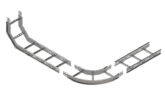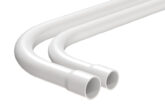
NAPIT’s Bill Allan looks at some of the common issues with flexible metal conduit and the answers to these.
The most common application for flexible conduit – whether it is metallic or non-metallic – is for short lengths, say up to 1m, from a solid conduit terminal box to an adjacent motor which is subject to movement and vibration.
But sometimes flexible conduit is used for longer runs, such as in locations where it is inappropriate or difficult to use rigid conduit. This could be the case where, for example, the walls are uneven or the conduit needs to run across a number of obstacles such as brick pillars.
Flexible metal conduit is generally considered easier to work with than rigid metal conduit, due to its flexibility. Yet questions persist over the use of flexible conduit, especially flexible metal conduit and we felt it would be of interest to answer some of these questions in an article.
Therefore, we’ll take a particular scenario involving flexible metal conduit and answer some questions which arise.
The scenario
A number of flush-mounted 13A socket-outlets have to be installed in a suspended floor and in a metal partition wall in an industrial installation. The internal construction of the metal partition wall includes metallic parts. The floor sockets and the wall sockets are to be supplied by single-core cables in flexible metal conduit from underfloor Powertrack. This will involve running lengths of flexible metal conduit up to 3m long from the underfloor Powertrack to the sockets. The flexible conduit in the metal partition wall will be installed at a depth of less than 50mm from the surface of the wall.
Some general comments
Regulation 521.4 of BS 7671 states that Powertrack systems must comply with the relevant part of the BS EN 61534 series. See also Appendix 8.
Flexible steel conduits are manufactured to BS EN 61386-23 in galvanised or stainless steel. They’re commonly available in sizes from 20 to 50mm and with a range of coverings, such as a PVC over-sheath, a low fire hazard coating and a braided steel covering. The braided steel covering provides EMC screening. In addition, a range of metal glands and other accessories are available.
As with all wiring systems, flexible metal conduit must be suitable for the external influences present. It is manufactured with a range of ingress protection ratings, such as IP 40, IP 55 and IP 65. It must be correctly installed and adequately supported throughout its length.
Is there a maximum allowable length of flexible conduit?
The practicalities of wiring single-core cables through lengths of flexible metal conduit which are longer than about 1m can be a concern and the use of a draw wire will usually prove to be almost indispensable for this task.
There is no restriction on the length of run of flexible conduits1 but specifications for particular jobs may give a maximum length.
An important consideration when installing longer runs of flexible conduit is the general appearance. Even with the use of a draw wire, it may be necessary to lay the flexible conduit straight out on the floor to thread the cables through it, prior to installing the conduit in its final position. (Regulation 522.8.2 which requires a conduit system to be completely erected between access points before any cable is drawn in, refers to conduit systems which are buried in a structure).
The consultant or designer should confirm that the installation meets the requirements with regard to earth fault loop impedance as required by BS 7671.
Can flexible metal conduit be used for earth continuity?
Regulation 543.2.3 prohibits the use of flexible metal conduit as a protective conductor. Therefore, it will be necessary to run a separate circuit protective conductor (cpc) with the flexible conduit and, for aesthetic purposes, it would be best to run the cpc inside the conduit rather than fix it by means of tape or ties to the outside of the conduit.
30mA RCD or mechanical protection?
Regulation 522.6.203 is applicable for flexible metal conduit which is to be installed in a metal partition wall, the internal construction of which includes metallic parts. This Regulation requires that the cable concealed in the metal partition wall must be additionally protected by a 30mA RCD or it must be mechanically protected in accordance with 522.6.204.
The provision of a 30mA RCD would satisfy the requirements of Regulation 522.6.203 without the need to also comply with Regulation 522.6.204.
However, Regulation 522.6.203 also indicates that, where a cable is installed at a depth of less than 50mm from the surface of a partition – as in the scenario – the requirements of Regulation 522.6.202 also apply.
Run in a zone or mechanical protection?
Regulation 522.6.202 requires that the conduit either be installed in a zone (see the wording of the Regulation for the details) or the cables must comply with the mechanical protection requirements of Regulation 522.6.204. It may or may not be possible to run the flexible conduit in a zone but, in any case, the provision of a 30mA RCD will satisfy the requirements of Regulation 522.6.202 as it satisfies the requirements of Regulation 522.6.203.
Does flexible metal conduit provide adequate mechanical protection?
The mechanical protection requirements of Regulation 522.6.204 are referred to in Regulations 522.6.201, 522.6.202 and 522.6.203.
The requirement in Regulation 522.6.204 which pertains to conduit is contained in item (ii). It deals with earthed conduit which satisfies the requirements of BS 7671 for a protective conductor and flexible metal conduit cannot comply with this particular requirement.
Therefore, unless mechanical protection is provided by some other means to prevent penetration of the cable by nails, screws and the like, such as that referred to in item (v) of Regulation 522.6.204, the use of flexible metal conduit alone cannot comply with the requirements of Regulation 522.6.204.
However, Regulation 433.2.2 and Regulation 434.2.1 of BS 7671 impose a maximum length of 3m on the position of devices for protection against overload and fault current respectively.
For more information please visit: https://www.napit.org.uk/









